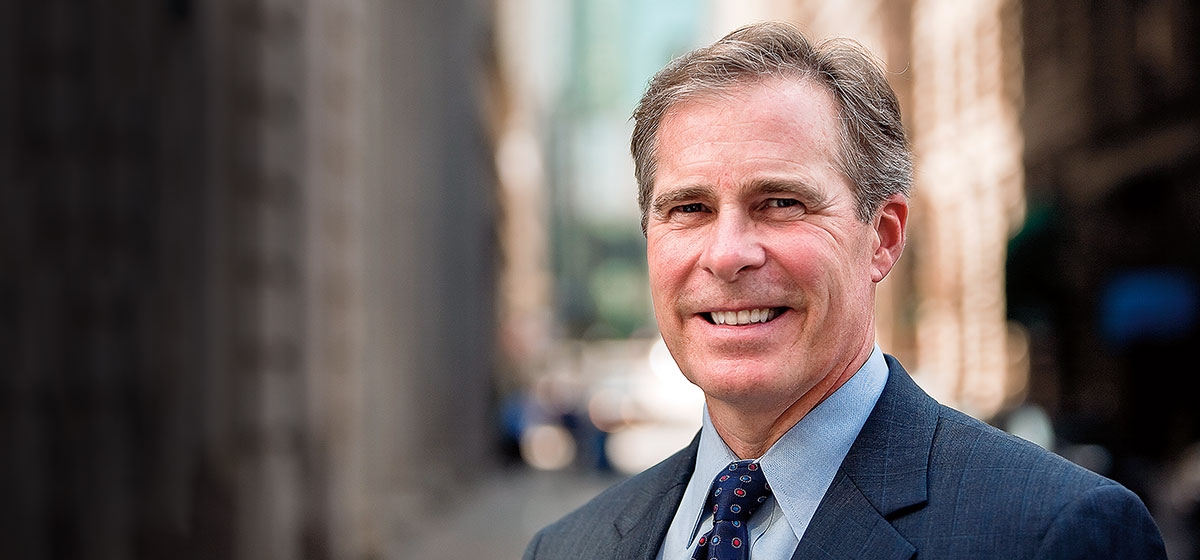Firing on All Cylinders

When Paul Hennigan became president of Point Park University in 2006, he inherited an institution that a little more than a decade earlier was in danger of going out of business. One of his first priorities was deciding the viability of the Pittsburgh Playhouse in Oakland. Eleven years later, the new Playhouse is set to open and Hennigan has forged changes that have made Point Park a major component in the revitalization of Downtown Pittsburgh.
Q. When will the new Pittsburgh Playhouse open and how do you anticipate it will reinvigorate offerings on campus and in that section of the city?
A. The new Playhouse will be finished in June and will open with the start of the school year next fall. It’s amazingly large —85,000 square feet—but connected to two historic buildings we own. So it seems like one big, seamless building. It will have three theaters, a large sound stage, a large scene shop, a large paint shop, several large rehearsal studios and dressing rooms. And the PNC Theater has a proscenium-and-thrust stage to give it maximum versatility.
It’s right on Forbes Avenue, one block from Market Square, and that area’s going to see significant revitalization over the next six to seven years. The next area the city’s focusing on is Smithfield Street, and this will be a catalyst to connect everything that’s happening in Market Square and Wood Street to what’s going to happen on Smithfield Street. It’s one of the big pieces in the Downtown revitalization puzzle.
Academically, the Playhouse will service all disciplines on campus. We’re coming up with a lot of really creative ideas. One of the features will be putting together interdisciplinary teams of students to do a wide variety of production-related projects. A student group may want to produce a play or another event. Someone’s going to write it, someone will produce, and others will choreograph, direct, do the budget, ticket sales and social media. In other words, every aspect of production will be done by interdisciplinary groups of students. All of it will be student- run—with adult supervision, of course—but it will be for all majors, not just the performing students.
We’re not aware of any other program like it in the country. It’s all part of our focus now on distinctive, innovative and experiential learning, and that satisfies all three of those. That’s our strategy for the entire university. It grew out of our strategic plan two years ago, and this is our first full year of implementing it.
Q. Last spring, you announced the opening of the Rowland School of Business. What niche will it fill and how is it going?
A. We were one of the first schools in the region to create an academic discipline of business, which only got started as a discipline in the late ’70s and early ’80s. So it’s been part of our DNA for a long time. But we had a benefactor who left us a $5 million gift so we could endow the school of business and make something unique out of it. So we’ve just started a cooperative education (co-op) program, in which qualified juniors and seniors have the opportunity to work 15 weeks, full time with local employers. They’re making real wages and getting great job experience as well as entree into a potential employer. We just started it a year ago, and it’s the biggest differentiating feature of the Rowland School of Business, in addition to our location next to all these companies who are looking for employees.
Based on all the workforce data coming out of the Allegheny Conference, this is our contribution to trying to keep local talent in Pittsburgh. There’s huge demand on the employer and the student side. But you have to nurture these things along and grow them the right way, so we’re doing it at a nice steady pace.
Q. You opened The Center for Media Innovation in September 2016 at a time when public trust in the media was the lowest in 40 years and when the revenue models for much of the traditional media were evaporating. What is the goal of the center, and what role do you envision it playing in the future of Pittsburgh media?
A. The goal is to help define the future role and relevance of organized media and to facilitate the identification of financially sustainable models of organized media. We’re seeing more and more media outlets go out of business. It requires new models, and we want to find them, highlight them and promote them.
Another goal is to promote organized media in what we now refer to as media deserts—places where there’s no organized media anymore. For instance, small communities where there’s no longer a newspaper. We’re trying to figure out what’s the best way to fill the void; we haven’t figured it out yet. But there are communities around Pittsburgh reaching out to us, saying, “Our borough council is corrupt and doing bad stuff.” But there are no checks and balances because there’s no reporting any more. We have to figure out, where’s the accountability mechanism when the media goes away?
The third goal is to be on the forefront of developing social media collegiate education. What are the rules and what are the standards? Everyone has jumped into social media, but there’s no real, well-structured college curriculum about how to do social media. So we’re taking existing journalistic standards and trying to apply them to a new paradigm.
Q. Point Park welcomed one of its largest incoming classes this fall. How do you see your future, enrollment-wise, in a very competitive environment?
A. There was a time, not long ago, when we were able to predict enrollment because most trends were linear and well defined. But ever since 2008, enrollment trends are practically nonexistent at most schools. There are a lot of market forces working against higher education. One is the high school demographic in the Northeast. Another is the discussion of the relevance and the cost. So the only way to try to mitigate that is to be relevant and to demonstrate relevance. And that’s why we have this renewed commitment to distinctive, innovative and experiential learning. That’s what our students want. Point Park is the size school that can provide that; not every school can. We happen to be ideally located, and we’re not so big that we can’t work with and manage each student we have.
Our freshmen class is around 600, full-time, first-time students. We also bring in transfers, grad students and doctorate students. And overall, the economics work. However, like every other school in the country, we’re constantly looking at expenditure reduction. I remember the days when enrollment trends were as linear as could be, and they were all heading up. Now it’s different. One year, a certain area’s strong. Another year, it’s another area. We have four doctoral programs, on-ground master’s degree programs, and a large online component. When you blend all of those together, the economics work.
Q. I remember writing a story 25 years ago about Point Park possibly going out of business. Now it seems to be firing on all sorts of new cylinders and doing better than ever. What’s the challenge for the future?
A. The pace of change is so fast now. Like Moore’s Law, the pace of change seems to double every two years. And if we’re indeed in this society with accelerating change—not just change—then higher education has to, at a minimum, keep up with it and, ideally, try to be ahead of it. So we’re putting out students who can enter a workforce with such a rapid pace of change. And the ability to deal with rapid change is almost becoming a required skill set.
We spend a lot of time talking about that at Point Park. As Thomas Friedman wrote, if you’re whitewater rafting, in order to keep the raft from flipping, you have to keep the raft moving as fast as the water. So we have to keep ourselves moving as fast or faster than the pace of change.
We have a very clear sense of direction at the university. What’s happening here in a very organic way is we have passionate emerging leaders across the board. They have vision, and they understand the pace of change and how to keep up with it. And they’re all doing beautiful work.
That’s the phenomenon that’s occurring at Point Park right now, and my job is to enable it. That’s very different from five years ago, when it was more traditional leadership. Now, a big part of my job is nurturing these people. It’s a different form of leadership for a different time.




